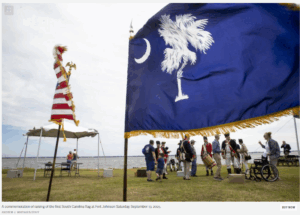Beginning at the Beginning
The Origins of Proslavery Christianity: White and Black Evangelicals in Colonial and Antebellum Virginia by Charles F. Irons, UNC Press.
Review Summary: The Origins of Proslavery Christianity is essential reading for any devoted student of American slavery, and recommended reading for those interested in Virginia history, religious history, or the history of American race relations.
The Origins of Proslavery Christianity provides an important new account of the rise of interracial evangelicalism in colonial and antebellum Virginia. As the title suggests, this book travels some well-worn historical turf, but the original narrative and interpretive strategies employed along the way make this a worthy contribution to the established canon on the proslavery argument. Many estimable scholars, including Drew Gilpin Faust, Bertram Wyatt-Brown, and most recently Lacy Ford, have explained how proslavery rhetoricians developed their arguments over time, consolidating social, political, and religious sentiments into an ideology that approached the level of sectional orthodoxy by the end of the antebellum period. Charles Irons traces the religious dimension of this development, but makes it clear from the outset that he intends to rework this narrative of transition through an emphasis on historical “process, and not outcome.” Even so, Irons’ book is very much a narrative of transitions. Each chapter adds a sequential layer to the development of interracial evangelicalism in Virginia, from the earliest Anglican considerations of the African soul to the symbolic ways in which black Christians inadvertently contributed to the spirit of Confederate nationalism.
The transitional moment at the center of Irons’ book is the maturation of evangelical attitudes towards race and slavery. During the early decades of the nineteenth century, white evangelicals harbored a wide variety of opinions on issues related to slavery, and afforded their black co-religionists a remarkable degree of autonomy and space in which to develop “ownership” of their faith. As Irons tells it, both proslavery and antislavery evangelicals grew to support the colonization movement, and many organized themselves into an interdenominational “united front” of benevolence, preparing Virginia blacks for freedom and sponsoring their emigration to Africa. In 1831, a Virginia slave and unlicensed preacher named Nat Turner launched a bloody insurrection that shocked the American south and rocked evangelical consciousness in Virginia. Turner’s rebellion unraveled the superficial truce between black and white, proslavery and antislavery Virginians, and compelled the state’s religious and secular leaders to reconsider and reconfigure the boundaries of “black spiritual initiative.” The policies that came out of this moment turned away from the prevailing ethos of African-American stewardship towards one of racial control. The evangelical united front abandoned colonization in favor of a domestic missionary movement that targeted Virginia slaves, a movement designed to attract and convert black members while at the same time undercutting the authority of black religious leaders.
As with the push for colonization, the mission movement required black participation. The prevalence of Christian slaves in Virginia demonstrated the success of missionary outreach, and also validated the fundamental assumption behind the movement – that slavery generated the best possible conditions in which to secure the salvation of black souls. Irons argues that the slave mission originated as a localized evangelical movement, but soon took on a “new political salience,” as “clumsier hands” crafted the slave missions into a rhetorical tool for use on a national stage increasingly preoccupied with sectional political conflict. In so doing, secular leaders transformed localized defenses of evangelical mission work into a general “defense of slavery per se.” As sectional conflicts became sectional crises by 1861, most white evangelicals clung to Unionism for two reasons: firstly, they believed that “disunion and disobedience to civil authorities were sinful;” secondly, earlier contemplations of antislavery in Virginia, resolved through open discourse, taught Virginians that the anxieties generated by Lincoln’s election could also be resolved within the bounds of the federal compact. It was not until Lincoln’s call for military mobilization that most white Virginians recognized the spiritual merit of secession. In spiritual terms, military coercion violated the federal compact and thus redeemed disunion of its sinfulness. If federal coercion threatened slavery, then “white Virginians needed to fight because they had a moral duty to protect the slaves.”
In order to retell the history of the proslavery argument in this way – with emphases on black influence, grassroots evangelicalism, and hidden processes of negotiation – Irons confronts a number of formidable practical challenges. In his effort to reconnect and reorient the available source materials to explain how black spiritual initiative shaped the development of proslavery Christianity, Irons accepts Erskine Clarke’s challenge to write the history of slavery as “two histories of one place and one time.” The careful and convincing manner in which Irons meets this challenge is the greatest accomplishment of his book. Irons describes the evangelical experience in antebellum Virginia from both white and black perspectives and meticulously weaves this duality through each chapter.
These histories are most remarkable where they intersect: in a mountain of evidence for African-American influence on white religious experience, ecclesiastical policies, and the development of proslavery ideology. Irons extrapolates on patterns of church membership to show how interracial fellowship became a trademark of evangelical identity and the interracial church became the place where white Christians learned from their black brethren of their obligations to the enslaved. To varying degrees, each of Virginia’s evangelical denominations conformed their structure to African-American demands. Irons uses denominational records and the personal writings of white religious leaders to document the formal and informal arrangements through which Baptists and Methodists recognized and accommodated black preference for black preachers. Irons also illustrates how white attention to black religion permeated the sermons, church records, and religious periodicals of the 1830s and 40s, as evangelical observers documented the growth of black church membership to demonstrate the merit of their mission movement. In the final chapter, Irons turns to a speech from John Randolph Tucker to demonstrate that Virginians viewed their part in the Civil War as a struggle to preserve the Christian work conducted via the master-slave relationship and validated by the willing engagement of Christian slaves.
Elegant argumentation enables Irons to work his way through the source difficulties that debilitate historical understanding of the slave experience, and goes a long way towards overcoming some of the other challenges involved in writing a book like this. In order to write a balanced history of religious activity that accounts for the different appeals and functions of religious practice, the challenge is to demonstrate how religion can become a mechanism for social control while also taking religious belief and believers seriously. Irons’ book successfully meets this challenge time and again. For example, Irons uses the postbellum testimony of a former slave, a scathing depiction of the monotonous sermonizing of the slave mission, to document the tendency of white evangelicals to reduce black religion to a gospel of obedience, but also encourages his readers to imagine the slave mission as “an earnest evangelistic endeavor.” It was not a singular gospel of social control that attracted tens of thousands of black Virginians to the evangelical church during the decades of the missionary program. Religious experience served a number of functions for black and white evangelicals, and social control was but one of these.
The challenge that Irons is least successful in overcoming is the one he created for himself. Irons distinguishes his book from much of the previous scholarship by emphasizing the processes through which white evangelicals learned about race and slavery through engagement with the actions of their black brethren, instead of the proslavery consensus that grew out of these processes. This is an important narrative strategy, one that strengthens the book when Irons is able to maintain it, but when Irons strays from this strategy, away from processes and towards outcomes, it leads him into flimsier arguments. For example, Irons seems to be emphasizing outcome when he suggests that the mission movement and the maturation of the religious argument for racial slavery emerged in response to the Turner rebellion. He writes that while the pre-Turner generations “assumed that slavery was a necessary precondition for colonization,” the post-Turner generation realized that slavery was “a necessary precondition for mission work.” In this assessment, Irons exaggerates both the “before” and “after” sides of contrast, and neglects some of the continuities and alternative explanations that are evident in other parts of the book. Through over-reliance upon the minority report of Virginia colonizationists, Irons disregards the tendencies towards proslavery prescriptions and racial restrictions that existed long before 1831. The mission movement became more self-conscious and organized during the 1830s, but the assumptions and objectives that motivated the movement, as well as the restrictive methods involved, were continuous with the evangelical doctrines and practices of the previous era.
The cumulative value of Irons’ book more than compensates for any of its isolated weaknesses. As the most socially and racially diverse units of antebellum culture, the interracial evangelical communities of the slave South are a gold mine for historical examination. Irons has unearthed a great deal of this historical gold. The Origins of Proslavery Christianity is essential reading for any devoted student of American slavery, and recommended reading for those interested in Virginia history, religious history, or the history of American race relations.



